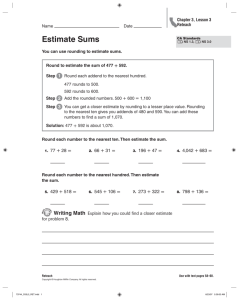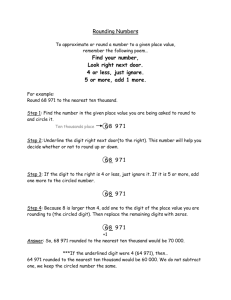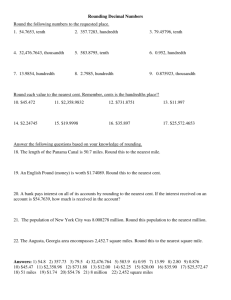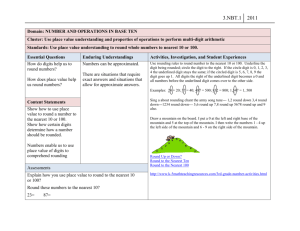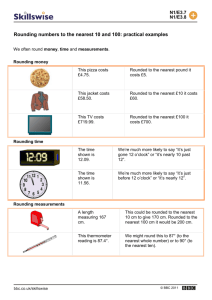Rounding & Estimation - VCC Library
advertisement
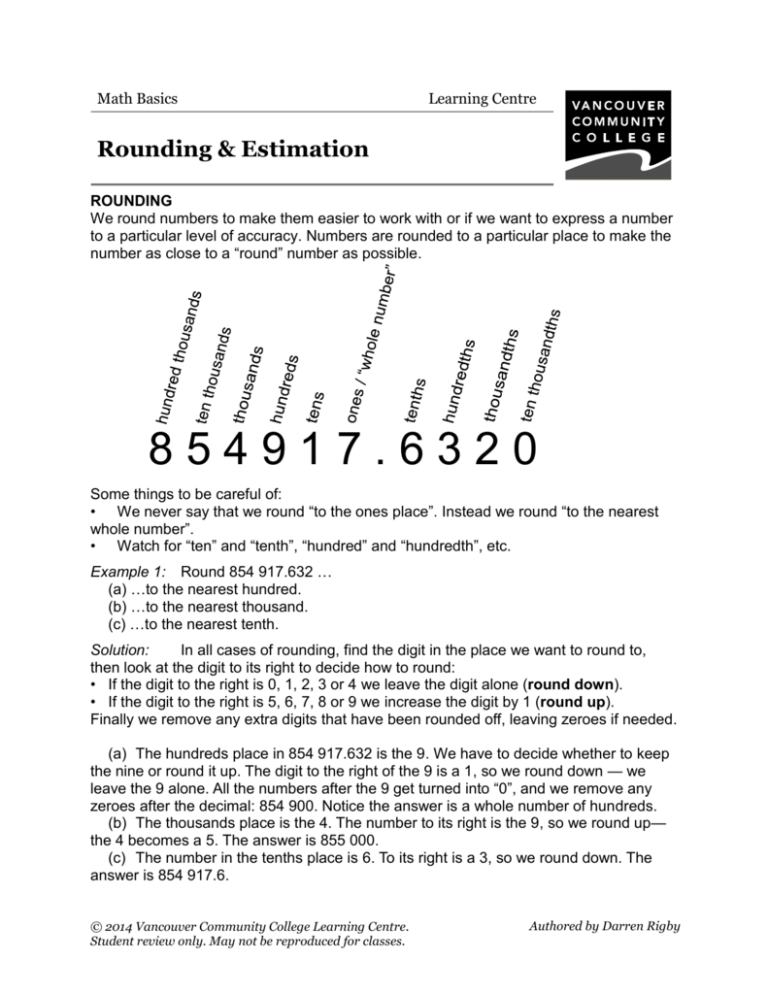
Math Basics Learning Centre Rounding & Estimation ROUNDING We round numbers to make them easier to work with or if we want to express a number to a particular level of accuracy. Numbers are rounded to a particular place to make the number as close to a “round” number as possible. 854917.6320 Some things to be careful of: • We never say that we round “to the ones place”. Instead we round “to the nearest whole number”. • Watch for “ten” and “tenth”, “hundred” and “hundredth”, etc. Example 1: Round 854 917.632 … (a) …to the nearest hundred. (b) …to the nearest thousand. (c) …to the nearest tenth. Solution: In all cases of rounding, find the digit in the place we want to round to, then look at the digit to its right to decide how to round: • If the digit to the right is 0, 1, 2, 3 or 4 we leave the digit alone (round down). • If the digit to the right is 5, 6, 7, 8 or 9 we increase the digit by 1 (round up). Finally we remove any extra digits that have been rounded off, leaving zeroes if needed. (a) The hundreds place in 854 917.632 is the 9. We have to decide whether to keep the nine or round it up. The digit to the right of the 9 is a 1, so we round down — we leave the 9 alone. All the numbers after the 9 get turned into “0”, and we remove any zeroes after the decimal: 854 900. Notice the answer is a whole number of hundreds. (b) The thousands place is the 4. The number to its right is the 9, so we round up— the 4 becomes a 5. The answer is 855 000. (c) The number in the tenths place is 6. To its right is a 3, so we round down. The answer is 854 917.6. © 2014 Vancouver Community College Learning Centre. Student review only. May not be reproduced for classes. AuthoredbybyEmily Darren Rigby Simpson Rounding with zeroes is a little different. Example 2: Round 6 973.502 1 … (a) …to the nearest hundred. (b) …to the nearest hundredth. Solution: (a) The 9 is in the hundreds place. The digit to the right of the 9 is a 7, so we round up. This should mean that we add 1 to the 9, but we can’t write “10”. Instead, we look at the numbers from the left up to the 9, which is 69… — and add one to that. 6 973 becomes 7 000. (b)The 0 is in the hundredths place. The digit to the right of the 0 is a 2, so we round down. The 0 stays as it is. We don’t show any numbers to the right of the zero, but we do write the zero! The answer is 6 973.50. WHAT’S THE DEAL WITH THE PENNY? The new laws about the penny have you rounding things in ways that seem to contradict the rules above. If your total ends with 3, you round up, and if it ends with 6, you round down! The reason is because we’re not rounding to the nearest place, but to the nearest coin. With the penny now gone, the smallest coin we can use to pay for things is the nickel. That means we can only pay amounts in cash that are multiples of 5 cents. If you buy something at the store, and the register says $13.76: $13.75 $13.80 $13.76 1 cent 4 cents The two amounts nearest $13.76 that you can pay without pennies are $13.75 (1 cent less) and $13.80 (4 cents more). $13.75 is closer, so that’s how the store rounds your total. The penny rule is different! With pennies, amounts ending in 1, 2, 6 and 7 round down, and amounts ending in 3, 4, 8 and 9 round up. If that’s confusing, remember this: You should never add or subtract more than 2 cents when rounding pennies. ESTIMATION A big part of being smarter at math is recognizing a wrong answer when you see one. A major problem for some students is that a single mistake in a calculation makes the whole answer wrong. Estimation helps you catch major errors, but only if it’s done right. The idea behind estimation is that you’re simplifying the problem you’re working on for two reasons: first, to make it easier so you’re less likely to make a mistake and second, to give you an idea of how big your answer should be. © 2014 Vancouver Community College Learning Centre. Student review only. May not be reproduced for classes. 2 Example 3: Add 63.75 + 156.4 + 92.78. Solution? 0.6.3.7.5 0.1.5.6.4 +.9.2.7.8 1.7.2.1.7 Is this the right answer? We can do a “sanity check” by estimating what the answer should be. Round each of the numbers in the problem so that each one only has one or two digits that aren’t a zero. For this problem, that might mean rounding to the nearest ten or the nearest hundred. (You’re just doing a check, so there’s no single “right answer”.) If we round to the nearest ten: 63.75 rounds to 70, 156.4 rounds to 160, and 92.78 rounds to 90. 70 + 160 + 90 is much easier to add. 70 + 160 + 90 = 320. The answer to the original problem should be close to 320. If instead we round to the nearest hundred, it’s even easier: 63.75 becomes 100, 156.4 becomes 200 and 92.78 becomes 100. 100 + 200 + 100 = 400. Note all three numbers were rounded up, so the answer should be close to 400, but definitely less than 400. By rounding up, we made all the numbers bigger, so the estimated total must be bigger than the real total. Either way, the calculated answer of 172.17 is too small—it’s not close to 320 or 400. This signals that there’s a mistake in the addition above. (Look closely — can you see what’s wrong?) The correct answer is 312.93, which is quite close to 320. By the way, you only need to do one kind of estimation for a problem. We showed you two possibilities, but in practice either one is enough. What if we had chosen to round to the nearest whole number, or to the nearest tenth? The estimations that would result would be 64 + 156 + 93 and 63.8 + 156.4 + 92.8. Both of these would give you very accurate estimates of the correct answer (313 for both of them — very close!) but these problems are just as hard as the original question. Good estimations are versions of your question that you can either do in your head or very quickly on paper. A useful thing to remember for estimation: When you multiply numbers that end in zeroes, multiply the non-zero parts, and add a zero for every zero in the problem. (30000 × 5000 = 15 0000 000) When you divide numbers that end in zeroes, divide the non-zero parts, and every zero in the first number (dividend) cancels a zero in the second number (divisor). (3500000 ÷ 500 = 7 000 00) © 2014 Vancouver Community College Learning Centre. Student review only. May not be reproduced for classes. 3 EXERCISES A. Round 1 854 270.936 to the nearest… 1) …thousand. 3) …hundredth. 2) …ten. 4) …whole number. B. Round 58 197.640 32 to the nearest… 1) …ten. 3) …ten thousand. 2) …ten thousandth. 4) …thousandth. C. For each of these amounts, determine what you would pay in cash. (In other words, round to the nearest nickel.) 1) $27.63 4) $162.14 2) $32.81 5) $9.98 3) $44.56 6) $17.70 D. For each of the following calculations and suggested estimations, decide if it’s a good estimation. 1) calculation: 135.67 – 23.93 3) calculation: 19965 ÷ 18 estimation: 140 – 20 estimation: 19970 ÷ 20 2) calculation: 2489 + 347 + 89 estimation: 20 + 30 + 80 4) calculation: 356.994 × 58.7 estimation: 400 × 60 E. Estimate the scale of the following calculations. Use your estimation to decide if the suggested answer likely to be the correct answer. 1) calculation: 365 + 1762 + 803 4) calculation: 517 × 19 suggested answer: 9230 suggested answer: 983 2) calculation: 7852 – 898 + 2019 suggested answer: 8793 5) calculation: 15 394 ÷ 31 suggested answer: 4965.80645… 3) calculation: 122 ÷ 6 suggested answer: 20.33333… 6) calculation: 198 × 39 suggested answer: 8722 SOLUTIONS A. (1) 1 854 000 (2) 1 854 270 (3) 1 854 270.94 (4) 1 854 271 B. (1) 58 200 (2) 58 197.640 3 (3) 60 000 (4) 58 197.640 C. (1) $27.65 (2) $32.80 (3) $44.55 (4) $162.15 (5) $10.00 (6) $17.70 D. (1) yes (2) no — 20 is not a good approximation of 2489 (3) no — calculation too hard (4) yes E. (1) no; = 2930 (2) yes (3) yes (4) no; = 9823 (5) no; = 496.5806… (6) no, should be less than 200 × 40; = 7722 © 2014 Vancouver Community College Learning Centre. Student review only. May not be reproduced for classes. 4
